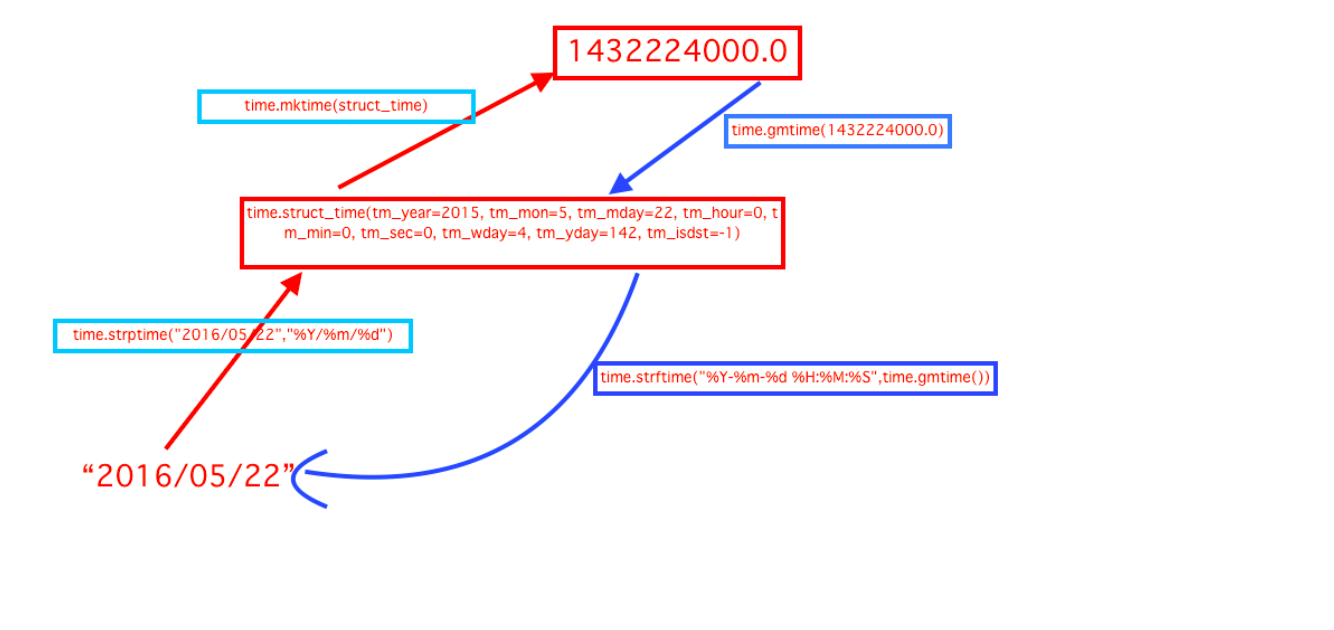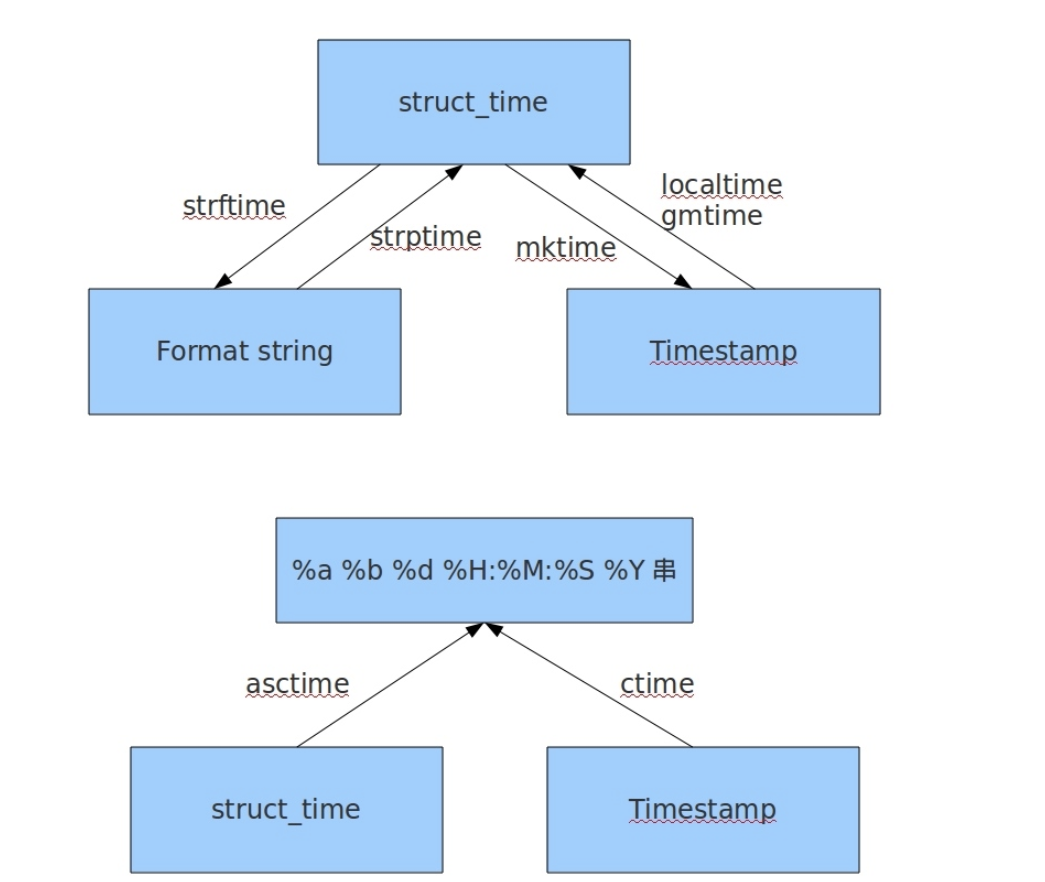模块(module)是 Python 中非常重要的东西,你可以把它理解为 Python 的扩展工具。换言之,Python 默认情况下提供了一些可用的东西,但是这些默认情况下提供的还远远不能满足编程实践的需要,于是就有人专门制作了另外一些工具。这些工具被称之为“模块”
任何一个 Pythoner 都可以编写模块,并且把这些模块放到网上供他人来使用。
当安装好 Python 之后,就有一些模块默认安装了,这个称之为“标准库”,“标准库”中的模块不需要安装,就可以直接使用。
如果没有纳入标准库的模块,需要安装之后才能使用。模块的安装方法,我特别推荐使用 pip 来安装。
在平常的代码中,我们常常需要与时间打交道。在Python中,与时间处理有关的模块就包括:time,datetime,calendar(很少用,不讲),下面分别来介绍。
在开始之前,首先要说明几点:
一、在Python中,通常有这几种方式来表示时间:
- 时间戳
- 格式化的时间字符串
- 元组(struct_time)共九个元素。(由于Python的time模块实现主要调用C库,所以各个平台可能有所不同。)
二、几个定义
UTC(Coordinated Universal Time,世界协调时)亦即格林威治天文时间,世界标准时间。在中国为UTC+8。DST(Daylight Saving Time)即夏令时。
时间戳(timestamp)的方式:通常来说,时间戳表示的是从1970年1月1日00:00:00开始按秒计算的偏移量。我们运行“type(time.time())”,返回的是float类型。
元组(struct_time)方式:struct_time元组共有9个元素,返回struct_time的函数主要有gmtime(),localtime(),strptime()。下面列出这种方式元组中的几个元素:
索引(Index) 属性(Attribute) 值(Values) 0 tm_year(年) 比如2011 1 tm_mon(月) 1 - 12 2 tm_mday(日) 1 - 31 3 tm_hour(时) 0 - 23 4 tm_min(分) 0 - 59 5 tm_sec(秒) 0 - 61 6 tm_wday(weekday) 0 - 6(0表示周日) 7 tm_yday(一年中的第几天) 1 - 366 8 tm_isdst(是否是夏令时) 默认为-1
三,time模块的方法
3.1 常用函数
time.localtime([secs]):将一个时间戳转换为当前时区的struct_time。secs参数未提供,则以当前时间为准。 time.gmtime([secs]):和localtime()方法类似,gmtime()方法是将一个时间戳转换为UTC时区(0时区)的struct_time。 time.time():返回当前时间的时间戳。 time.mktime(t):将一个struct_time转化为时间戳。 time.sleep(secs):线程推迟指定的时间运行。单位为秒。 time.asctime([t]):把一个表示时间的元组或者struct_time表示为这种形式:'Sun Oct 1 12:04:38 2017'。如果没有参数,将会将time.localtime()作为参数传入。 time.ctime([secs]):把一个时间戳(按秒计算的浮点数)转化为time.asctime()的形式。如果参数未给或者为None的时候,将会默认time.time()为参数。它的作用相当于time.asctime(time.localtime(secs))。 time.strftime(format[, t]):把一个代表时间的元组或者struct_time(如由time.localtime()和time.gmtime()返回)转化为格式化的时间字符串。如果t未指定,将传入time.localtime()。
举例用法:
import time
# time模块的方法
# time.localtime([secs]):将一个时间戳转换为当前时区的struct_time。secs参数未提供,则以当前时间为准。
print(time.localtime())
# time.struct_time(tm_year=2018, tm_mon=3, tm_mday=13, tm_hour=13, tm_min=44, tm_sec=0, tm_wday=1, tm_yday=72, tm_isdst=0)
# time.gmtime([secs]):和localtime()方法类似,gmtime()方法是将一个时间戳转换为UTC时区(0时区)的struct_time。
print(time.gmtime())
# time.struct_time(tm_year=2018, tm_mon=3, tm_mday=13, tm_hour=5, tm_min=49, tm_sec=16, tm_wday=1, tm_yday=72, tm_isdst=0)
# time.time():返回当前时间的时间戳。
print(time.time())
# 1520920188.7989295
# time.mktime(t):将一个struct_time转化为时间戳。
a = time.localtime()
print(time.mktime(a))
# time.sleep(secs):线程推迟指定的时间运行。单位为秒。
time.sleep(0.1)
print("hello world")
# time.asctime([t]):把一个表示时间的元组或者struct_time表示为这种形式:
# 'Sun Oct 1 12:04:38 2017'。如果没有参数,将会将time.localtime()作为参数传入。
a = time.localtime()
print(time.asctime(a))
# time.ctime([secs]):把一个时间戳(按秒计算的浮点数)转化为time.asctime()的形式。
# 如果参数未给或者为None的时候,将会默认time.time()为参数。它的作用相当于time.asctime(time.localtime(secs))。
print(time.ctime())
# time.strftime(format[, t]):把一个代表时间的元组或者struct_time(如由time.localtime()和time.gmtime()返回)
# 转化为格式化的时间字符串。如果t未指定,将传入time.localtime()。
print(time.strftime("%Y-%m-%d %X", time.localtime()) )
#输出2018-03-13 14:22:13
# time.strptime(string[, format]):把一个格式化时间字符串转化为struct_time。实际上它和strftime()是逆操作。
print(time.strftime("2018-03-13 14:26:23"))
# 2018-03-13 14:26:23
3.2 time模块常用的格式化字符串
| 格式 | 说明 |
|---|---|
| %a | 显示简化星期名称 |
| %A | 显示完整星期名称 |
| %b | 显示简化月份名称 |
| %B | 显示完整月份名称 |
| %c | 本地相应的日期和时间表示 |
| %d | 显示当月第几天 |
| %H | 按24小时制显示小时 |
| %I | 按12小时制显示小时 |
| %j | 显示当年第几天 |
| %m | 显示月份 |
| %M | 显示分钟数) |
| %p | 本地am或者pm的相应符 |
| %S | 显示秒数) |
| %U | 一年中的星期数 |
| %w | 显示在星期中的第几天,默认从0开始表示周一 |
| %W | 和%U基本相同 |
| %x | 本地相应日期 |
| %X | 本地相应时间 |
| %y | 去掉世纪的年份(00 - 99) |
| %Y | 完整的年份 |
| %Z | 时区的名字(如果不存在为空字符) |
| %% | ‘%’字符 |
3.3 时间函数之间的转化关系

四,datetime模块的方法
相对于time 模块,datetime模块的接口则更直观,更容易调用
4.1datetiem模块定义了下面这几个类:
datetime.date:表示日期的类。常用的属性有year, month, day; datetime.time:表示时间的类。常用的属性有hour, minute, second, microsecond; datetime.datetime:表示日期时间。 datetime.timedelta:表示时间间隔,即两个时间点之间的长度。 datetime.tzinfo:与时区有关的相关信息。(这里不详细充分讨论该类,感兴趣的童鞋可以参考python手册)
我们需要记下下面几个方法就ok
-————1,d=datetime.datetime.now() 返回当前的datetime日期类型
d.timestamp(),d.today(), d.year,d.timetuple()等方法可以调
import datetime d = datetime.datetime.now() print(d) d1 = d.time() print(d1) d2 =d.today() print(d2) d3 = d.year print(d3) d4 = d.timestamp() print(d4) d5 = d.timetuple() print(d5) # 2018-03-13 14:46:13.649710 # 14:46:13.649710 # 2018-03-13 14:46:13.649710 # 2018 # 1520923573.64971 # time.struct_time(tm_year=2018, tm_mon=3, tm_mday=13, tm_hour=14, tm_min=46, tm_sec=13, tm_wday=1, tm_yday=72, tm_isdst=-1)
————2.datetime.date.fromtimestamp(322222) 把一个时间戳转为datetime日期类型
import datetime import time d = datetime.date.fromtimestamp(0) print(d) # 1970-01-01 d =time.time() d1 = datetime.date.fromtimestamp(d) print(d1) # 2018-03-13
————3.时间运算(datetime.timedelta)
# 3时间运算 import datetime d = datetime.datetime.now() print(d) # 2018-03-13 14:51:02.755716 d1 = datetime.datetime(2017, 10, 1, 12, 53, 11, 821218) print(d1) # 2017-10-01 12:53:11.821218 d2 = datetime.datetime.now() + datetime.timedelta(4) #当前时间 +4天 print(d2) # 2018-03-17 14:51:53.457663 d3 = datetime.datetime(2018, 3, 12, 14, 52, 35, 276589) print(d3) # 2018-03-12 14:52:35.276589 d4 = datetime.datetime.now() + datetime.timedelta(hours=4) #当前时间+4小时 print(d4) # 2018-03-13 18:53:08.109074
————4,时间替换
# 4时间替换 import datetime d = datetime.datetime.now() print(d) d1 = d.replace(year=2999,month=11,day=30) print(d1) d2 = datetime.date(2999, 11, 30) print(d2) # 2018-03-13 14:56:16.880071 # 2999-11-30 14:56:16.880071 # 2999-11-30
4.2 date类
date类表示一个日期。日期由年、月、日组成(地球人都知道~~)。date类的构造函数如下:
date.min: 返回 date(MINYEAR, 1, 1). date.max: 返回 date(MAXYEAR, 12, 31). date.year: 返回 年, MINYEAR和MAXYEAR之间 date.month: 返回 月, 1到12月之间 date.day: 返回 1到 n 之间.
- year的范围是[MINYEAR, MAXYEAR],即[1, 9999];
- month的范围是[1, 12]。(月份是从1开始的,不是从0开始的_);
- day的最大值根据给定的year, month参数来决定。例如闰年2月份有29天;
- date类定义了一些常用的类方法与类属性,方便操作:
- date.max、date.min:date对象所能表示的最大、最小日期;
- date.resolution:date对象表示日期的最小单位。这里是天。
- date.today():返回一个表示当前本地日期的date对象;
- date.fromtimestamp(timestamp):根据给定的时间戮,返回一个date对象;
4.3 实例方法
date.replace(year, month, day):返回一个相同值的data对象, 除了这些参数给关键字指定新的值. date.timetuple(): 返回一个time.struct_time对象. date.toordinal(): 返回一个Gregoian Calendar对象. date.weekday(): 返回day of the week. 星期一为0,星期日为6. date.isoweekday(): 返回day of the week. 星期一为1,星期日为7. date.isocalendar(): 返回一个三元组, (ISO year, ISO week number, ISO weekday). date.isoformat(): 返回 一个'YYYY-MM-DD'的字符串格式. date.ctime(): 返回一个字符串日期, d.ctime() 等同于 time.ctime(time.mktime(d.timetuple())). date.strftime(format): 返回一个字符串日期, 格式自定义.
